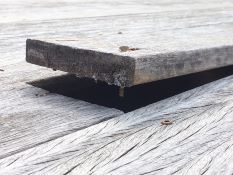REPLACING DECK BOARDS, AND DECK REPAIR IN DECATUR, AL
Big_KP • December 15, 2019

REPLACING DECK BOARDS
Are your decking boards cracked or split?
Are they twisted or curled?
Are your decking boards sagging or bouncy?
Do you have large or unsightly gaps between decking boards?
Do you have nails popping up above the surface of your decking boards?
These are all signs of decking boards that need to be replaced or deck repairs in your decks future.
If you need decking boards replaced or deck repairs you’ve found the right place.
You might be asking, why has this happened to my deck? Listed below I will answer that question, as well as others you might have about your deck.
What caused my deck boards to crack or split?
The most common reason decking boards crack and split are as follows:
The most frequent reason is, it’s a deck that isn’t being stained, sealed, or preserved annually.
Decking is designed to last for years, even in a harsh outdoor environment. For the longest deck life, your deck requires maintenance or it will wear out prematurely. Staining and sealing your deck is similar to changing the oil in your car engine. It is much needed preventative maintenance required to get the longest service life.
Now, this isn’t the only reason decking boards crack and split.
This next reason is more of a natural cause, decks like all building materials both expand and contract with changes in temperature and humidity.
Now, properly sealing your deck will cause less movement however, it will not eliminate it entirely. Even if your deck is sealed yearly most of us do not climb under our decks and seal the structure beneath.
Every decking board is held in place with many nails or screws. Any deck built in the last decade or so should be using screws. Exterior decking screws have more holding power than nails and make a more secure deck structure.
If the entire decking structure isn’t sealed adequately, that structure starts to dry out and shrink at a different rate than the decking boards. When this happens it will put an enormous amount of stress on the decking boards.
After many repeated hot, cold cycles and deck movements, the decking boards have no choice but to crack. Your deck will give at the weakest point. The decking boards are usually the first to show these signs of deterioration.
In this scenario, replacing decking boards might be your best option but, make sure you do a thorough inspection of your deck’s structure to ensure it is in good condition. Do not just throw down some new decking boards.
If you are unsure about anything, I recommend you seek professional guidance for a complete deck inspection.
Operation Handyman can help you out with that, or with a complete decking board replacement.
Why are my deck boards twisted or curled (cupped)?
Decking boards tend to cup naturally depending on several factors, including installation methods and quality of materials.
Below are a few other possible reasons.
The first reason, decking boards cup and twist are not having enough fasteners, nails or screws in the decking boards or having fasteners that are too short. Each decking board should have two or more fasteners at each joist location to properly secure them.
The length of the fasteners being used is equally as important. The decking boards should be fastened with at least two exterior deck screws that are two and three-quarter inch or three-inches long at each joist for maximum holding power and the minimal amount of movement and cupping.
The second reason might be that spacing in-between the joists is too far, the norm is 16″ on center, but 12″ on center can really help to minimize the boards cupping and also greatly increases the overall strength of decks structure.
The third reason might be the direction in which the grain in the boards was turned when it was installed.
The end of each decking board should be evaluated before it is placed and screwed down to minimize cupping and twisting.
When laid the wrong way the decking boards are more likely to cup, but even if laid incorrectly fastener size and placement will still reduce the likelihood of cupping and twisting.
The fourth reason is that the quality of the decking boards that are chosen. The old saying you get what you pay for comes in to play here. The higher quality the decking boards that are chosen, the less issues they tend to have.
Why are my deck boards sagging or bouncy?
There are a couple of important things to consider here.
First of all, you want to make sure it is only the decking boards that are sagging or bouncy and not the deck structure itself. If it is just the decking that is sagging or bouncy then most likely the joists are spaced too far apart.
If the whole deck is moving then you should immediately have the deck inspected by a professional as this can be serious and potentially dangerous or even deadly.
Why do I have large gaps between decking boards?
The reason for large gaps between decking boards is because of the natural characteristics of lumber and installation methods.
Lumber when first installed is green or at least partially green. This means that over time the lumber will dry out and shrink.
If the decking boards are installed with a large gap between them initially, as they dry out and shrink, the gaps will become larger.
If you commonly throw backyard barbeques or dinner parties, decks with large gaps are something you should be cautious of. If anyone decides to wear high heels, the point of the heel can become lodged in the decking and potentially cause an injury.
Why are nails popping above my deck surface or deck boards lifting?
Decking boards can lift and nails can pop naturally due to the expansion and contraction I mentioned above. That is why screws are recommended.
Undersized nails and too few nails also contribute again to this. Also, nails that are not making good penetration into the joist below can also contribute.
In closing, there are many decking board options available to you today, many more than there were 10-15 years ago. The options are way too numerous to mention in this post.
If you are interested in learning about more options, or interested in Replacing deck boards or deck repairs call Operation Handyman today.
This is the first post in my series of deck repair posts, bookmark my page or check back soon for more posts.
Thanks
Kevin your neighborhood Handyman
Now that you know more about what your deck needs and why it needs it, you might be wondering how do you fix it?
You might even be asking, why should I call Operation Handyman?
Operation Handyman has repaired decks frequently. I know the codes and how to make your deck safe, secure, and aesthetically pleasing.
I know which support brackets to install to make your existing deck stronger. I know what a proper ledger attachment looks like. I understand the process of deck building, and how to make sure you get the most out of your deck for years to come.
Call today and get on my schedule and I can start replacing deck boards for you.
Find more informative Blog posts by clicking here.
See my Facebook page and my reviews by clicking here.








